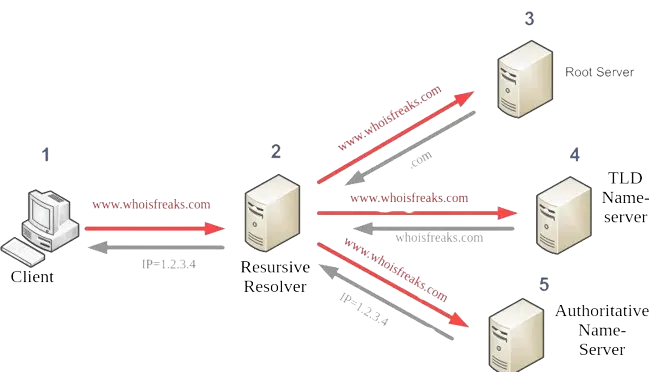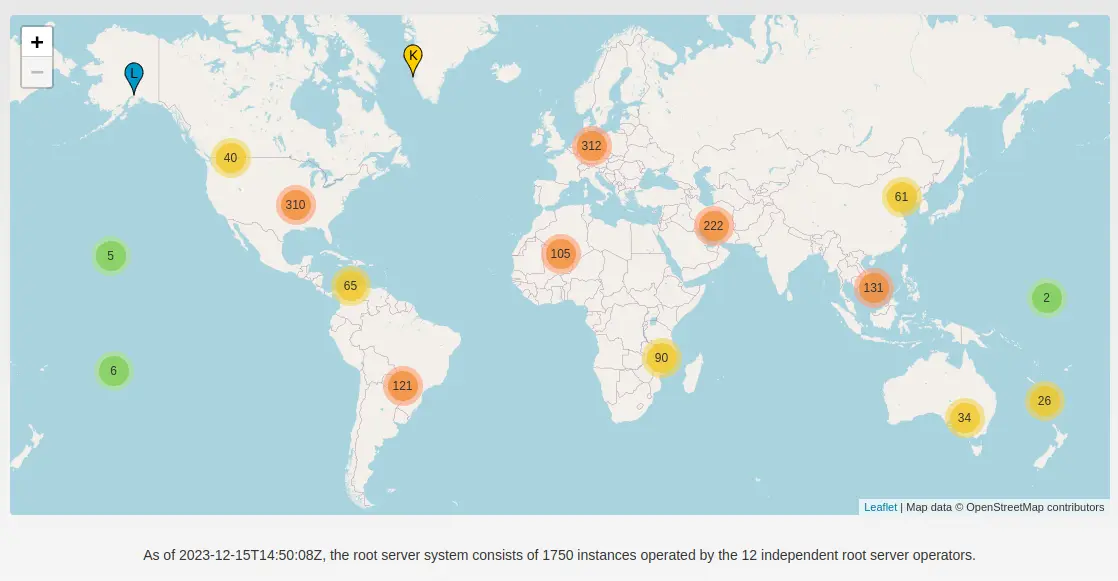
DNS Root Servers
In the vast expanse of the web, billions of users access internet services daily. Domain Name System (DNS) plays a crucial role in ensuring seamless internet navigation.
Computers and Servers use IP addresses to communicate with each other. They are like addresses for the digital world. DNS plays a pivotal role in translating user-friendly domain names into numerical IP addresses. It functions as a internet's address book.
Imagine having to memorize and type in complex numbers every time you wanted to visit a website. DNS eliminates this complexity, making the internet more accessible and user-friendly. It makes sure you smoothly reach your desired online destination when entering a domain name.
In the complex world of DNS, DNS root servers stand out as the foundation of the globally connected system. Root name servers, while not directly used by regular users, play a crucial role in the background. They make the entire DNS resolution process possible.
In this blog post, we'll explore the significance of DNS root servers. We'll delve into their essential functions and see how they enhance the robustness and reliability of the internet. We'll also discover the entities who manage the DNS root servers.
What are Root DNS Servers?
The domain name is a structured hierarchy that labels computers, services, and resources across the vast Internet. At the top of this hierarchy is the root domain, represented by an empty string in the domain name structure.
In the visual display of the domain name, the root domain is at the top of every Fully Qualified Domain Name (FQDN). It acts like a conceptual full stop or label delimiter. Consider a website like "www.whoisfreaks.com.", where the trailing dot signifies the acknowledgment of the root domain.
Modern DNS resolution software often recognizes this automatically. The terminal dot is not strictly necessary to translate domain names to IP addresses. But, it subtly acknowledges the foundational role of the root domain in shaping the cohesive structure of the DNS.

In DNS management, a carefully structured hierarchy unfolds into specific managed sections called "DNS zones". At its zenith is the DNS root zone, serving as the basis of the entire DNS infrastructure. In this crucial zone, the essential players, called DNS root servers, operate.
Situated in the root zone, these servers are authoritative DNS name-servers. They are responsible for handling queries at the highest level of the DNS hierarchy. They directly respond to queries within the root zone. In this way, they play a crucial role in the initial phases of DNS resolution.
How DNS works
Here's a step-by-step guide of the domain name resolution process using "www.whoisfreaks.com." as an example:
- When you type "www.whoisfreaks.com." into your web browser, the DNS recursive resolver gets the DNS query. This resolver can be part of your computer's operating system or your Internet Service Provider (ISP).
- The operating system's DNS resolver first checks if it already has the website information stored in its memory (cache). It forwards the request to the ISP's DNS resolver if it hasn't found from cache. If the DNS server at the ISP has the needed information in its cache, it responds directly.
- If the ISP's DNS server doesn't have the information, it reaches out to one of the root servers for guidance. Every ISP has a root name server list to query. The root server then provides the ISP's DNS resolver with the name-server for the top-level domain (TLD), which, in our case, is '.com'.
- The recursive resolver then asks the TLD name-server for the authoritative name-server of the domain name.
- Next, the recursive resolver asks the authoritative server, which manages the domain's zone, for the IP address of "www.whoisfreaks.com.". The authoritative server responds with the needed IP address or another domain name in case of CNAME record.
- If the name-server for the domain name returns another domain name, the process repeats. This repetition is necessary to obtain the IP address.
- The web browser now has the necessary IP address and can access the desired website, "www.whoisfreaks.com.".

This systematic process, involving root servers, TLD servers, and authoritative servers, ensures efficient and reliable domain name resolution across the internet.
Who maintains the DNS Root Servers?
A group of organizations called Root Server Operators (RSOs) shares the responsibility for maintaining the DNS root servers. Currently, 12 root server operators maintain root servers out of which 9 belong to the United States of America. These entities except Verisign, Inc. operate and manage individual instances of root servers.
Verisign, Inc. uniquely operates two root servers. They collectively contribute to the stability and reliability of the DNS infrastructure. Below is a list of all root server operators along with their respective countries of origin.
| Operator | Origin Country |
|---|---|
| Verisign, Inc. | USA |
| University of Southern California, Information Sciences Institute | USA |
| Cogent Communications | USA |
| University of Maryland | USA |
| NASA (Ames Research Center) | USA |
| Internet Systems Consortium, Inc. | USA |
| US Department of Defence (NIC) | USA |
| US Army (Research Lab) | USA |
| Netnod | Sweden |
| RIPE NCC | Netherlands |
| ICANN | USA |
| WIDE Project | Japan |
The coordination of these efforts is overseen by the Internet Assigned Numbers Authority (IANA), a function administered by the Internet Corporation for Assigned Names and Numbers (ICANN). The collaboration between IANA and the Root Server System Advisory Committee (RSSAC) plays a crucial role in ensuring the smooth operation of the root server system.
This distributed and collaborative approach enhances the resilience of the DNS. It also mitigates the risk of single points of failure. It underscores the global cooperation required to maintain the critical infrastructure that forms the backbone of the internet.
How many DNS root servers are there?
There are 13 unique IP addresses assigned to root servers. Below is a list of the 13 DNS root servers and their respective operators.
| Hostname | IPv4 address | IPv6 address | Operator |
|---|---|---|---|
| a.root-servers.net | 198.41.0.4 | 2001:503:ba3e::2:30 | Verisign, Inc. |
| b.root-servers.net | 170.247.170.2 | 2801:1b8:10::b | University of Southern California, Information Sciences Institute |
| c.root-servers.net | 192.33.4.12 | 2001:500:2::c | Cogent Communications |
| d.root-servers.net | 199.7.91.13 | 2001:500:2d::d | University of Maryland |
| e.root-servers.net | 192.203.230.10 | 2001:500:a8::e | NASA (Ames Research Center) |
| f.root-servers.net | 192.5.5.241 | 2001:500:2f::f | Internet Systems Consortium, Inc. |
| g.root-servers.net | 192.112.36.4 | 2001:500:12::d0d | US Department of Defense (NIC) |
| h.root-servers.net | 198.97.190.53 | 2001:500:1::53 | US Army (Research Lab) |
| i.root-servers.net | 192.36.148.17 | 2001:7fe::53 | Netnod |
| j.root-servers.net | 192.58.128.30 | 2001:503:c27::2:30 | Verisign, Inc. |
| k.root-servers.net | 193.0.14.129 | 2001:7fd::1 | RIPE NCC |
| l.root-servers.net | 199.7.83.42 | 2001:500:9f::42 | ICANN |
| m.root-servers.net | 202.12.27.33 | 2001:dc3::35 | WIDE Project |
Today, each of the 13 IP addresses for DNS root servers has multiple instances across different locations worldwide. They use Anycast routing, a smart way to handle DNS requests.
Anycast routing efficiently directs and distributes global DNS traffic. It directs the query to the least congested and nearest dns root server location in the cluster.
As of December 15, 2023, there are more than 1750 instances of root servers in the world. They are spanning over every populated continent.

Currently, there are 12 root server operators, each deploying varying numbers of instances, both global and local. Global instances allow route advertisements to spread throughout the entire internet, providing widely available service.
On the other hand, local instances restrict route advertisements to nearby networks, catering to specific needs and requirements. All operators ensure service to the entire internet through at least one global instance. Some may opt to deploy local instances based on their unique considerations and those of their provider partners.
Conclusion
The DNS, especially the DNS root servers, is crucial for a smooth internet experience. Twelve Root Server Operators under IANA and ICANN collaboratively manage it. This ensures redundancy and global availability.
This cooperative approach boosts DNS stability, minimizes risks, and underscores global operator's critical role. Root servers employ Anycast routing, mapping 13 unique IP addresses to thousands of global instances. This technology caters to global needs, ensuring a streamlined and efficient domain name resolution process.

Ex-Product Manager
A product Manager with deep expertise in cybersecurity, adept at analyzing cyber threat data to enhance product resilience against emerging security threats.
Related Posts

Understanding DNS Poisoning: Risks and Prevention ...
Discover essential insights on DNS poisoning and learn practical steps to safeguard your online presence. Read the article for vital protection tips.
Published at: Nov 7, 2025

Defending Against DNS Flood Attacks: Leveraging Wh...
Learn how a DNS flooder can threaten your network security and discover practical measures to protect your systems. Read more to safeguard your networ...
Published at: Oct 27, 2025

What is the Purpose of DNS Server? Understanding I...
Discover the essential role of DNS servers in internet functionality and learn how they enhance your online experience. Read the article for insights.
Published at: Oct 24, 2025

5 DNS Misconfigurations That Could Be Damaging You...
Discover 5 common DNS misconfigurations that can harm your email reputation. Ensure your emails land in inboxes, not spam. Read the article for soluti...
Published at: Jun 3, 2025